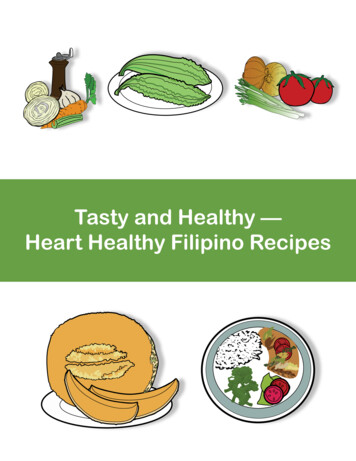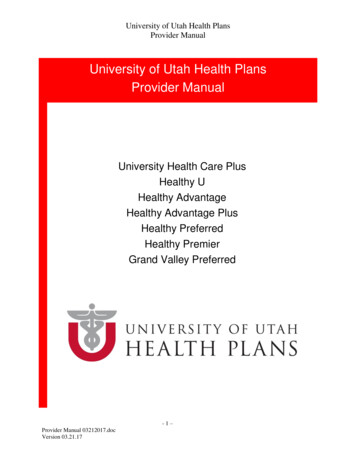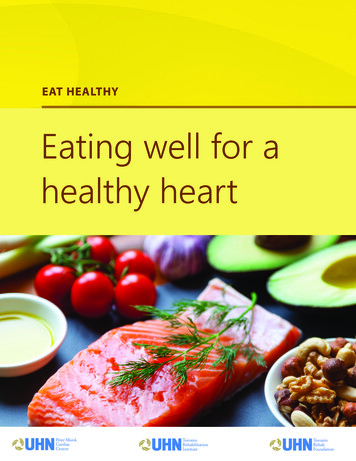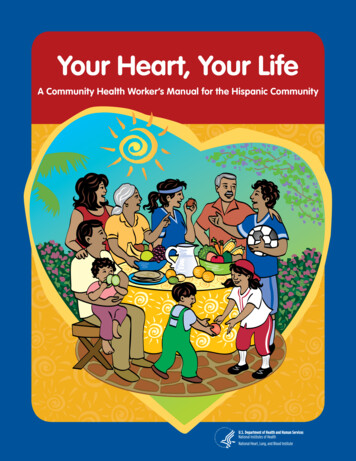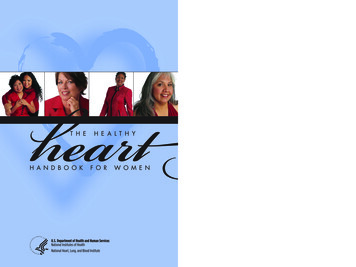
Transcription
ear T H EH A N D B O O KH E A L T H YF O RW O M E N
The National Heart, Lung, and Blood Institute (NHLBI) would like to express itsgratitude to all of the women whose pictures and stories appear in this handbook.They have shared their stories from the heart to help other women understand thatheart disease is not just a statistic, but a disease that affects the lives of realwomen, of all ages and backgrounds, in every community in our country.We are also pleased to announce that this edition of “The HealthyHeart Handbook for Women” marks the 20th anniversary of thispublication. Since the first edition rolled off the presses in 1987,this best-selling NHLBI book has reached hundreds of thousands ofwomen with a vital, empowering message: You can take action toprotect your heart health. As always, we hope that the stories ofcourage and healing in these pages will continue to inspire readersto act to protect their own health and well being. Thank you!
T H E H E A LT H Y ear HANDBOOK FOR WOMEN
Mrs. Laura Bush, National Ambassador for The Heart Truth
Written by: Marian SandmaierNIH Publication No. 07-2720Originally printed 1987Previously revised 1992, 1997, 2003, 2005Revised March 2007
TA B L E O Fcon en sABOUT THIS NEW EDITION �——————————————— 7THE HEART TRUTH ��———— 8GETTING THE WORD OUT �——————————————— 10WHAT IS HEART DISEASE? �——————————————— 11WOMEN AT RISK ��———— 12Every Risk Factor Counts �——————————————— 13FINDING OUT YOUR RISK �————————————— 15You and Your Doctor: A Heart Healthy Partnership —————————————— 15MAJOR RISK FACTORS FOR HEART DISEASE ———————————————— 21Smoking ��—————————— 21High Blood Pressure ��—— 22High Blood Cholesterol �� 29Overweight and Obesity �——————————————— 38Physical Inactivity ��———— 42Diabetes ��—————————— 43OTHER FACTORS THAT AFFECT HEART DISEASE —————————————— 49Menopausal Hormone Therapy: What Every Woman Needs To Know ———— 49Stress and Depression �� 52Alcohol ��—————————— 55Birth Control Pills ��———— 56Sleep Apnea ��—————— 58TAKING CONTROL ��—— 60A FAMILY PLAN FOR HEART HEALTH �————— 61AN ACTION PLAN FOR HEART HEALTH �——— 62Eat for Health ��—————— 63Aim for a Healthy Weight �——————————————— 83Learn New �———— 94You Can Stop Smoking �——————————————— 101FOR WOMEN WHO HAVE HEART DISEASE ———————————————— 107Screening Tests ��———— 107Medications ��—————— 112Special Procedures ��—— 114GETTING HELP FOR A HEART ATTACK �——— 115Know the Warning ——————————————— 115Get Help Quickly ��—— 116Plan Ahead ��—————— 117THE HEART OF THE MATTER �——————————— 119HOW TO ESTIMATE YOUR ��———————— 120TO LEARN MORE ��—— 121—5—
“ T H E H E A RT T R U T H M E A N S TA K I N GCARE OF YOURSELF AND YOURH E A R T — I N S I D E A N D O U T.IT IS ALONG-TERM COMMITMENT AND GOALT O L I V E A H E A LT H YL I F E , O N E T H AT I SHARMONIOUS.”–Orlinda—6—
abou THIS NEW EDITIONResearch on women’s heart health is exploding. Nearly everyweek, it seems, the media report on new ways to prevent and treatheart disease in women—and it can be hard to keep track of it all.In this updated edition of “The Healthy Heart Handbook forWomen,” we have put together all of this new knowledge in oneeasy-to-use handbook. This guide is part of The Heart Truth, anational public awareness campaign for women about heartdisease sponsored by the National Heart, Lung, and Blood Institute(NHLBI) and many other groups. (See “Getting the Word Out” onpage 10.)“The Healthy Heart Handbook for Women” will give you newinformation on women’s heart disease and practical suggestionsfor reducing your own personal risk of heart-related problems.You’ll find out about a little-known form of heart disease in womenand how to get it diagnosed properly. The handbook will alsohelp you make sense of widely publicized research on the impactof a lower fat diet on women’s heart disease risk.There is much good news in these pages, including new findings thatpeople who avoid heart disease risk factors tend to live healthier andlonger lives. The handbook will give you the latest information onpreventing and controlling those risks. You’ll also find new tips onfollowing a nutritious eating plan, tailoring your physical activity programto your particular goals, and getting your whole family involved in hearthealthy living. The handbook will also advise you on the warning signsof heart attack, as well as how to act quickly to get help.So welcome to “The Healthy Heart Handbook for Women”—yourone-stop source for the latest information on women’s heart diseaseand heart health.—7—
THE ear WTRUTHhen you hear the term “heart disease,”what is your first reaction? Like many women,you may think, “That’s a man’s disease” or “Not myproblem.” But here is The Heart Truth: Heart disease is the #1killer of women in the United States. Most women don’t know this.But it is vital that you know it—and know what it means for you.Some surprising facts: One in 4 women in the United States dies of heart disease,while 1 in 30 dies of breast cancer. Twenty-three percent of women will die within 1 year afterhaving a heart attack. Within 6 years of having a heart attack, about 46 percent ofwomen become disabled with heart failure. Two-thirds ofwomen who have a heart attack fail to make a full recovery.The fact is, if you’ve got a heart, heart disease could be yourproblem. Fortunately, it’s a problem you can do somethingabout. This handbook will help you find out your own risk ofheart disease and take steps to prevent and control it.For women in midlife, taking action is particularly important.Once a woman reaches menopause, her risks of heart diseaseand heart attack jump dramatically. One in eight womenbetween the ages of 45 and 64 has some form of heart disease,and this increases to one in four women over 65.—8—
One in 4 women in the United States diesof heart disease, while 1 in 30 dies ofbreast cancer.You still may be thinking, “But this isn’t about me. I don’t haveheart disease.” But you may have conditions or habits that canlead to heart disease, such as being overweight, smokingcigarettes, or not engaging in enough physical activity. Youmay already know about these and other “risk factors” for heartdisease. You may know which ones you personally have.What you may not know, though, is that if you have even onerisk factor, you are much more likely to develop heart disease,with its many serious consequences. A damaged heart candamage your life by interfering with enjoyable activities andeven your ability to do simple things, such as taking a walkor climbing steps.But now here’s the good news: You have tremendous power toprevent heart disease—and you can start today. By learningabout your own personal risk factors and by making healthfulchanges in your diet, physical activity, and other daily habits,you can greatly reduce your risk of developing heart-relatedproblems. Even if you already have heart disease, you can takesteps to lessen its severity.So use this handbook to learn more about heart healthy living.Talk with your physician to get more answers. Start taking actiontoday to protect your heart. As one woman doctor put it, “Heartdisease is a ‘now’ problem. Later may be too late.”—9—
GETTING THEwor OUTChances are, you’ve been seeing and hearing a lot ofinformation lately on women and heart disease. That’sbecause an exciting public awareness campaign isunderway to help women protect their heart health. Thepurpose of this nationwide campaign, called The Heart Truth,is to spread the word that heart disease is a women’s issue.The Heart Truth warns women about heart disease andencourages them to take action against its risk factors.The message is paired with an arresting image—the RedDress—the national symbol for women and heart diseaseawareness. The symbol links a woman’s focus on her “outer self”to the need to also focus on her “inner self,” especially her hearthealth. The Red Dress is a visual “red alert” to convey themessage that “Heart Disease Doesn’t Care What You Wear—It’sthe #1 Killer of Women.”The Heart Truth campaign is sponsored by the National Heart,Lung, and Blood Institute in partnership with many national andcommunity health organizations around the country. So the nexttime you come across a red dress, or a newspaper article or localspeaker on women and heart disease, take the time to get themessage. The Heart Truth: It could save your life.For more information, visit the campaign’s Web pages atwww.hearttruth.gov.— 10 —
W H AT I S ear DISEASE?Coronary heart disease—often simply called heart disease—occurs when the arteries that supply blood to the heart musclebecome hardened and narrowed due to a buildup of plaque onthe arteries’ inner walls. Plaque is the accumulation of fat,cholesterol, and other substances. As plaque continues to buildup in the arteries, blood flow to the heart is reduced.Heart disease can lead to a heart attack. A heart attackhappens when an artery becomes totally blocked with plaque,preventing vital oxygen and nutrients from getting to the heart.A heart attack can cause permanent damage to the heart muscle.Heart disease is one of several cardiovascular diseases, whichare diseases of the heart and blood vessel system. Othercardiovascular diseases include stroke, high blood pressure,and rheumatic heart disease.One reason some women aren’t too concerned about heartdisease is that they think it can be “cured” with surgery. This isa myth. Heart disease is a lifelong condition—once you get it,you’ll always have it. True, procedures such as bypass surgeryand angioplasty can help blood and oxygen flow to the heartmore easily. But the arteries remain damaged, which means youare more likely to have a heart attack.What’s more, the condition of your blood vessels will steadilyworsen unless you make changes in your daily habits. Manywomen die of complications from heart disease or becomepermanently disabled. That’s why it is so vital to take action toprevent and control this disease.— 11 —
womenAT R I S KRisk factors are conditions or habits that make a person morelikely to develop a disease. They also can increase the chancesthat an existing disease will get worse. Important risk factors forheart disease that you can do something about are cigarettesmoking, high blood pressure, high blood cholesterol, overweight,physical inactivity, and diabetes. Research shows that more than95 percent of those who die from heart disease have at leastone of these major risk factors.Some risk factors, such as age and family history of early heartdisease, can’t be changed. For women, age becomes a riskfactor at 55. Women who have gone through early menopause,either naturally or because they have had a hysterectomy, aretwice as likely to develop heart disease as women of the sameage who have not yet gone through menopause. Anotherreason for the increasing risk is that middle age is a time whenwomen tend to develop other risk factors for heart disease.Family history of early heart disease is another risk factor thatcan’t be changed. If your father or brother had a heart attackbefore age 55, or if your mother or sister had one before age65, you are more likely to get heart disease yourself.While certain risk factors cannot be changed, it is important torealize that you do have control over many others. Regardlessof your age, background, or health status, you can lower yourrisk of heart disease—and it doesn’t have to be complicated.Protecting your heart can be as simple as taking a brisk walk,whipping up a good vegetable soup, or getting the support youneed to maintain a healthy weight.— 12 —
Every Risk Factor CountsSome women believe that doing just one healthy thing will take careof all of their heart disease risk. For example, they may think that ifthey walk or swim regularly, they can still smoke and stay fairlyhealthy. Wrong! To protect your heart, it is vital to make changesthat address each risk factor you have. You can make the changesgradually, one at a time. But making them is very important.Other women may wonder, “If I have just one risk factor for heartdisease—say, I’m overweight or I have high blood cholesterol—aren’t I more or less ‘safe’?” Absolutely not. Having just one riskfactor can double a woman’s chance of developing heart disease.The “Multiplier Effect”But having more than one risk factor is especially serious, becauserisk factors tend to “gang up” and worsen each other’s effects.Having two risk factors increases the chance of developing heartdisease fourfold. Having three or more risk factors increases thechance more than tenfold.The fact is, most women in midlife already have heart diseaserisk factors. Thirty-three percent of women ages 40 to 60 haveone risk factor for heart disease that they can change. Another31 percent of women in midlife have two modifiable risk factors,while 17 percent have three or more modifiable risk factors.Women of color have higher rates of some risk factors. Morethan 85 percent of African American women in midlife areoverweight or obese, while 52 percent have high bloodpressure, and 14 percent have been diagnosed with diabetes.Among Hispanic women in midlife, 78 percent are overweightor obese, while more than 10 percent have been diagnosedwith diabetes.The message is clear: Every woman needs to take her heartdisease risk seriously—and take action now to reduce that risk.— 13 —
DIDyouKNOW?Many women think that breast cancer is a bigger threat thanheart disease. But the leading causes of death for Americanwomen in the year 2004* were:Heart Disease332,313Cancer (all types) 265,022 Lung Breast 40,539 Colorectal26,762 Pancreatic15,815 Ovarian 14,593 Uterine Cervical OthersStroke67,8386,9063,80488,76591,487Chronic Obstructive Pulmonary DiseaseAlzheimer’s DiseaseAccidents64,40946,95438,903Diabetes 37,771Pneumonia/Influenza33,902* Most recent year for which data are available.— 14 —
DIDyouKNOW?FINDING OUTMany women think that breast cancer is a bigger threat thanheart disease. But the leading causes of death for Americanwomen in the year 2004* were:Heart DiseaseTyou RISKhe first step toward heart health is becomingaware of your own personal risk for heart disease.Some risks, such as smoking cigarettes, are332,313Cancer (all types) 265,022obvious: Every woman knows whether or not she smokes.But other risk factors, such as high blood pressure or high bloodcholesterol, generally don’t have obvious signs or symptoms.So you’ll need to gather some information to create your personal Lung67,838 Breast 40,539 Colorectal26,762You and Your Doctor: A Heart Healthy Partnership Pancreatic15,815A crucial step in determining your risk is to see your doctor for a Ovarian 14,593thorough checkup. Your physician can be an important partner Uterinein helping you set and reach goals for heart health. But don’t Cervical Others6,9063,80488,765“heart profile.”wait for your doctor to mention heart disease or its risk factors.Many doctors don’t routinely bring up the subject with womenpatients. Research shows that women are less likely than menStroke91,487Chronic Obstructive Pulmonary Disease64,409to receive heart healthy recommendations from their doctors.Here are some tips for establishing good, clear communicationbetween you and your doctor:Alzheimer’s Disease46,954Speak up. Tell your doctor you want to keep your heartAccidents38,903Diabetes 37,771Pneumonia/Influenza33,902healthy and would like help in achieving that goal. Askquestions about your chances of developing heart disease andhow you can lower your risk. (See “Questions To Ask YourDoctor” on page 17.) Also ask for tests that will determine yourpersonal risk factors. (See “Check It Out” on pages 18 and 19.)* Most recent year for which data are available.— 14 —— 15 —
Keep tabs on treatment. If you already are being treatedfor heart disease or heart disease risk factors, ask your doctor toreview your treatment plan with you. Ask, “Is what I’m doing inline with the latest recommendations? Are my treatmentsworking? Are my risk factors under control?” If your doctorrecommends a medical procedure, ask about its benefits andrisks. Find out if you will need to be hospitalized and for howlong, and what to expect during the recovery period.Be open. When your doctor asks you questions, answer ashonestly and fully as you can. While certain topics may seemquite personal, discussing them openly can help your doctor findout your chances of developing heart disease. It can also helpyour doctor work with you to reduce your risk. If you alreadyhave heart disease, briefly describe each of your symptoms.Include when each symptom started, how often it happens, andwhether it has been getting worse.Keep it simple. If you don’t understand something yourdoctor says, ask for an explanation in simple language. Beespecially sure you understand how to take any medication youare given. If you are worried about understanding what thedoctor says, or if you have trouble hearing, bring a friend orrelative with you to your appointment. You may want to ask thatperson to write down the doctor’s instructions for you.— 16 —
Keep tabs on treatment. If you already are being treatedQUESTIONS TO ASK YOURfor heart disease or heart disease risk factors, ask your doctor todocto review your treatment plan with you. Ask, “Is what I’m doing inGetting answers to these questions will give you vital informationline with the latest recommendations? Are my treatmentsabout your heart health and what you can do to improve it.working? Are my risk factors under control?” If your doctorYou may want to take this list to your doctor’s office:recommends a medical procedure, ask about its benefits andrisks. Find out if you will need to be hospitalized and for howlong, and what to expect during the recovery period.Be open. When your doctor asks you questions, answer ashonestly and fully as you can. While certain topics may seem1. What is my risk for heart disease?2. What is my blood pressure? What does it mean for me,and what do I need to do about it?3. What are my cholesterol numbers? (These include totalquite personal, discussing them openly can help your doctor findcholesterol, LDL or “bad” cholesterol, HDL or “good”out your chances of developing heart disease. It can also helpcholesterol, and triglycerides.) What do they mean for me,your doctor work with you to reduce your risk. If you alreadyand what do I need to do about them?have heart disease, briefly describe each of your symptoms.Include when each symptom started, how often it happens, andwhether it has been getting worse.Keep it simple. If you don’t understand something yourdoctor says, ask for an explanation in simple language. Beespecially sure you understand how to take any medication youare given. If you are worried about understanding what thedoctor says, or if you have trouble hearing, bring a friend orrelative with you to your appointment. You may want to ask thatperson to write down the doctor’s instructions for you.4. What are my body mass index (BMI) and waist measurement?Do they indicate that I need to lose weight for my health?5. What is my blood sugar level, and does it mean I’m at riskfor diabetes?6. What other screening tests for heart disease do I need?How often should I return for checkups for my heart health?7. What can you do to help me quit smoking?8. How much physical activity do I need to help protectmy heart?9. What is a heart healthy eating plan for me? Should I seea registered dietitian or qualified nutritionist to learn moreabout healthy eating?10. How can I tell if I’m having a heart attack?— 16 —— 17 —
chec IT OUTTests That Can Help Protect Your Heart HealthAsk your doctor to give you these tests. Each one will give youvaluable information about your heart disease risk.Lipoprotein ProfileWhat: A blood test that measures total cholesterol, HDL or“good” cholesterol, LDL or “bad” cholesterol, and triglycerides,another form of fat in the blood. The test is given after a 9- to12-hour fast.Why: To find out if you have any of the following: high bloodcholesterol (high total and LDL cholesterol), low HDL cholesterol,or high triglyceride levels. All affect your risk for heart disease.Fasting Plasma GlucoseWhat: The preferred test for diagnosing diabetes. After you havefasted overnight, you will get a blood test the following morning.Why: To find out if you have diabetes or are likely to develop thedisease. Fasting plasma glucose levels of more than 126 mg/dLon two tests on different days mean that you have diabetes. Levelsbetween 100 and 125 mg/dL mean you have an increased riskfor diabetes and may have prediabetes. Diabetes is an importantrisk factor for heart disease and other medical disorders.When: At least every 3 years, beginning at age 45. If you haverisk factors for diabetes, you should be tested at a younger ageand more often.Body Mass Index (BMI) and Waist CircumferenceWhen: All healthy adults should have their blood cholesterolWhat: BMI is a measure of your weight in relation to your height.levels checked at least once every 5 years. Depending on theWaist circumference is a measure of the fat around your middle.results, your doctor may want to repeat the test more frequently.Blood PressureWhat: A simple, painless test using an inflatable cuff on the arm.Why: To find out whether your body type raises your risk ofheart disease. A BMI of 25 or higher means you are overweight.A BMI of 30 or higher means you are obese. Both overweightand obesity are risk factors for heart disease. For women, a waistWhy: To find out if you have high blood pressure (also calledmeasurement of more than 35 inches increases the risk of hearthypertension) or prehypertension. Both are risk factors for heartdisease and other serious health conditions.disease.When: Every 2 years, or more often if your doctor recommends it.When: At least every 2 years, or more often if you have highblood pressure or prehypertension.Other TestsThere also are several tests that can determine whether you alreadyhave heart disease. Ask your doctor whether you need a stresstest, an electrocardiogram (EKG or ECG), or another diagnostictest. (See “Screening Tests” on page 105.)— 18 —— 19 —
Fasting Plasma GlucoseWhat: The preferred test for diagnosing diabetes. After you havefasted overnight, you will get a blood test the following morning.Why: To find out if you have diabetes or are likely to develop thedisease. Fasting plasma glucose levels of more than 126 mg/dLon two tests on different days mean that you have diabetes. Levelsbetween 100 and 125 mg/dL mean you have an increased riskfor diabetes and may have prediabetes. Diabetes is an importantrisk factor for heart disease and other medical disorders.When: At least every 3 years, beginning at age 45. If you haverisk factors for diabetes, you should be tested at a younger ageand more often.Body Mass Index (BMI) and Waist CircumferenceWhat: BMI is a measure of your weight in relation to your height.Waist circumference is a measure of the fat around your middle.Why: To find out whether your body type raises your risk ofheart disease. A BMI of 25 or higher means you are overweight.A BMI of 30 or higher means you are obese. Both overweightand obesity are risk factors for heart disease. For women, a waistmeasurement of more than 35 inches increases the risk of heartdisease and other serious health conditions.When: Every 2 years, or more often if your doctor recommends it.Other TestsThere also are several tests that can determine whether you alreadyhave heart disease. Ask your doctor whether you need a stresstest, an electrocardiogram (EKG or ECG), or another diagnostictest. (See “Screening Tests” on page 105.)— 19 —
W H AT ’ Syou RISK?MAJOR RISK FACTORS FORHere is a quick quiz to find out your risk of a heart attack.YesDon’tNo KnowDo you smoke?Is your blood pressure 140/90 mmHg or higher, ORhave you been told by your doctor that your bloodpressure is too high?Has your doctor told you that your LDL (“bad”)cholesterol is too high, OR that your total cholesterollevel is 200 mg/dL or higher, OR that your HDL(“good”) cholesterol is less than 40 mg/dL?Has your father or brother had a heart attack before age55, OR has your mother or sister had one before age 65?Do you have diabetes OR a fasting blood sugar of126 mg/dL or higher, OR do you need medicine tocontrol your blood sugar?Are you over 55 years old?Do you have a body mass index (BMI) score of 25or more? (To find out, see page 41.)A ear DISEASEs important as it is to work closely with yourdoctor, it is only the first step. To make a lastingdifference in your heart health, you’ll also needto educate yourself about heart disease and about the kinds ofhabits and conditions that can raise your risk. It’s your heart, andyou’re in charge. What follows is a basic guide to the mostimportant risk factors for heart disease and how each of themaffects a woman’s health.SmokingSmoking is “the leading cause of preventable death and diseasein the United States,” according to the Centers for Disease Controland Prevention. Women who smoke are two to six times morelikely to suffer a heart attack than nonsmoking women, and therisk increases with the number of cigarettes smoked each day.Smoking can also shorten a healthy life, because smokers are likelyto suffer a heart attack or other major heart problem at least 10years sooner than nonsmokers. Smoking also raises the risk of stroke.But heart disease and stroke are not the only health risks forwomen who smoke. Smoking greatly increases the chances thata woman will develop lung cancer. In fact, the lung cancer deathDo you get less than a total of 30 minutes ofmoderate-intensity physical activity on most days?rate for women is now higher than the death rate for breastcancer. Cigarette smoking also causes many other types ofHas a doctor told you that you have angina (chestpains), OR have you had a heart attack?cancer, including cancers of the mouth, urinary tract, kidney, andcervix. Smoking also causes most cases of chronic obstructivelung disease, which includes bronchitis and emphysema.If you checked any of the “yes” boxes, you’re at an increased risk ofhaving a heart attack. If you checked “don’t know” for any questions,ask your doctor for help in answering them. Read on to learn whatyou can do to lower your risk.If you smoke indoors, the “secondhand smoke” from yourcigarettes can cause heart disease, lung cancer, and other serioushealth problems in the nonsmokers around you. According to arecent report from the U.S. Surgeon General, exposure to smokeat home or work increases a nonsmoker’s risk of developing heart— 20 —— 21 —
MAJOR RISK FACTORS FORA ear DISEASEs important as it is to work closely with yourdoctor, it is only the first step. To make a lastingdifference in your heart health, you’ll also needto educate yourself about heart disease and about the kinds ofhabits and conditions that can raise your risk. It’s your heart, andyou’re in charge. What follows is a basic guide to the mostimportant risk factors for heart disease and how each of themaffects a woman’s health.SmokingSmoking is “the leading cause of preventable death and diseasein the United States,” according to the Centers for Disease Controland Prevention. Women who smoke are two to six times morelikely to suffer a heart attack than nonsmoking women, and therisk increases with the number of cigarettes smoked each day.Smoking can also shorten a healthy life, because smokers are likelyto suffer a heart attack or other major heart problem at least 10years sooner than nonsmokers. Smoking also raises the risk of stroke.But heart disease and stroke are not the only health risks forwomen who smoke. Smoking greatly increases the chances thata woman will develop lung cancer. In fact, the lung cancer deathrate for women is now higher than the death rate for breastcancer. Cigarette smoking also causes many other types ofcancer, including cancers of the mouth, urinary tract, kidney, andcervix. Smoking also causes most cases of chronic obstructivelung disease, which includes bronchitis and emphysema.If you smoke indoors, the “secondhand smoke” from yourcigarettes can cause heart disease, lung cancer, and other serioushealth problems in the nonsmokers around you. According to arecent report from the U.S. Surgeon General, exposure to smokeat home or work increases a nonsmoker’s risk of developing heart— 21 —
disease by 25 to 30 percent. Secondhand smoke is especiallyharmful to infants and young children, causing
underway to help women protect their heart health. The purpose of this nationwide campaign, called The Heart Truth, is to spread the word that heart disease is a women’s issue. The Heart Truthwarns women about heart disease and encourages them to take action against its risk facto




